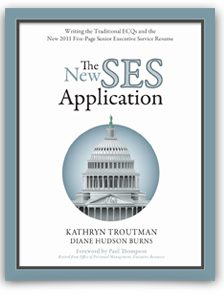 Want to join America’s most elite group of senior professionals, the Senior Executive Service (SES)?
Want to join America’s most elite group of senior professionals, the Senior Executive Service (SES)?
Already there and eying another position? The Federal Government’s Office of Personnel Management (OPM) estimates that as many as 50% of federal senior executives employed at the start of 2011 will leave government by the end of 2015. The mass departure of these Baby Boom-generation federal executives will create a crucial need for strong new Federal workforce leaders. But if you want to join the SES, you first must learn how to jump through many application hoops. These are not easy jobs to get.
The New SES Application, the latest title from noted Federal Career authors Kathryn Troutman and Diane Hudson Burns and award-winning Federal Career Publishers, adeptly covers the challenges and intricacies of applying for the best Federal jobs available today, the Senior Executive Service (SES). This just-released book covers all new changes in SES applications since the Office of Personnel Management’s (OPM) decision in 2008 to pilot a new method for SES applications, adopted by many agencies since 2009. Now is the time to think SES, as the OPM predicts a surge of retirements by senior executive Baby Boomers over the next four years.
Part of the challenge is that these are the most senior Federal civil service jobs, and have highly demanding technical and leadership qualifications. Another challenge comes from President Obama’s 2010 initiative calling for improvements in federal recruitment and hiring. Applying for SES positions can be confusing.
“The process of applying for SES has changed a lot recently,” notes Federal Job Guru Kathryn Troutman, one of the co-authors of The New SES Application (Fall 2011, $21.95, 189 pp.). “They’re trying to get rid of the separate essay-style narratives, the 10-page Executive Core Qualification Statements (ECQs), and they created a comprehensive five-page SES federal resume to replace it. Not all the agencies are doing it, so the book was created to cover all the various possible requirements.”
Her co-author Diane Hudson Burns notes that applicants need to scrutinize their selected vacancy announcements carefully. The announcements will reveal which SES application format should be used. Chapter 3 explains how to analyze announcements and it describes the different formats in use.
“However I would suggest you prepare a full SES application in advance,” Hudson Burns says. “Then, when an announcement is posted, you can customize the documents to fit the specific opening. Otherwise, you might be scrambling and miss an application deadline.”
Books from Federal Career Publishers, a division of Troutman’s Resume Place, are known for their top-rate samples of resumes and other application pieces, and this most recent title is no exception (see Chapter 9). Another helpful feature of The New SES Application is Chapter 7, “Lessons Learned.” It’s the “What Not To Do” chapter. “It’s based on actual feedback applicants received from OPM,” reveals Troutman, “and includes crucial writing tips and the main reasons an application might be rejected.”
This book presents a process for writing the application package based on years of in-class training experience. The authors recommend kick-starting the writing by drafting a list of your Top 10 Accomplishments (Chapter 4). “Thank you, David Letterman,” Troutman joked. “When you write your accomplishments, and spell out what you’ve done, it gives you a solid starting place.”
Wondering if you’re SES ready? “The Leadership Journey” chart at the beginning of Chapter 2 can help as it displays the competencies required at the different management levels in federal government. The chart can also help you plan for a federal senior-executive career. Additionally, the book is a great resource for employees being groomed within a government agency for SES through a Federal Candidate Development Program.
The SES hiring process uses the application and the interview together to score candidates. “The structured interview format is the most popular for SES,” notes Troutman (see Chapter 8).
A two-day intensive SES workshop run by the Resume Place utilizes The New SES Application as a text. The workshop offers support on application writing and interview prep for federal managers and administrators, military officers and senior enlisted, as well as private industry executives considering SES careers. Attendees learn about the SES corps, develop a 5-page SES federal resume, and practice their interviews using video and class feedback. The next scheduled SES Application Writing Course is January 17-18 in Catonsville, MD.
It can take 20 hours or more to write a SES application package. Troutman’s firm also offers consulting and writing services for time-pressed executives and others who need support beyond the book. Bryan Hochstein is an SES applicant who decided to turn to the Resume Place for help in writing his application and prepping for the interview. “They obviously have the experience, and understand the process,” he observed. “Out of fifty candidates, I was among the top five who qualified for an interview.” Another one of Hudson Burns’ clients received three SES job interviews and two job offers after working with her on a SES application. “I have been dreaming of obtaining an SES position for 25 years,” the applicant revealed. “You helped me achieve a personal goal.”
“Writing the SES application is really about articulating leadership,” explains Hudson Burns. “It’s a complex process, but it is necessary to meet the SES requirements. The book explains all the nuances of the application process clearly, including development of what I call the ‘super resume’, the new five-page SES/ECQ combined resume.”






